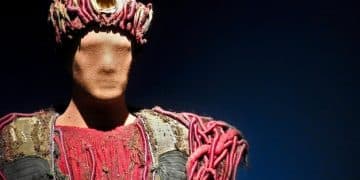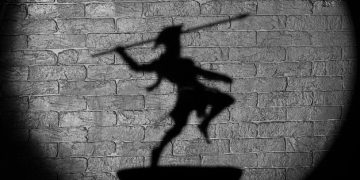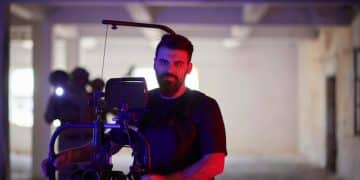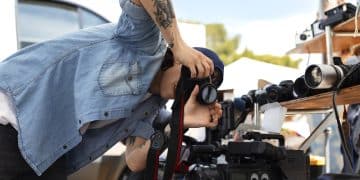Wardrobe shapes character: Costume design unveiled
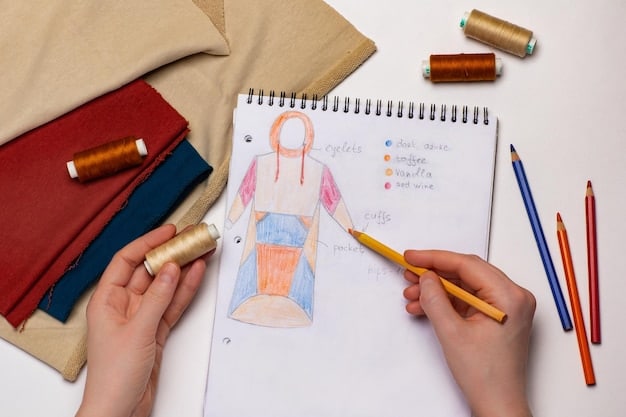
Costume design goes beyond aesthetics, acting as a silent language where wardrobe shapes character, revealing identity, emotions, and social roles through fabric, color, and silhouette.
In filmmaking, every wardrobe choice is deliberate: each stitch, color, and texture transforms actors into memorable characters, proving that wardrobe shapes character and tells stories without words.
Beyond the seams: The philosophy of costume in storytelling
Costume design is an often-underestimated cornerstone of visual storytelling.
It’s not simply about fashion or historical accuracy; it’s a deliberate artistic choice, a non-verbal language that communicates deep insights into the characters we see on screen.
Every garment is imbued with meaning, acting as a silent narrator of personal journeys, societal standing, and emotional states.
Recognizing how wardrobe shapes character allows filmmakers to create more nuanced portrayals.
Understanding this philosophy reveals that a character’s wardrobe is a dynamic element, evolving with their narrative arc. It can reflect internal conflict, signify a turning point, or even foreshadow future events.
This deep integration makes costume design an essential, organic part of the storytelling process, far from a mere afterthought, precisely because wardrobe shapes character in tangible ways.
The psychology of color and fabric
The choice of color and fabric in costume design is far from arbitrary. Each hue and texture carries psychological weight, influencing how an audience perceives a character.
A vibrant red dress might signal defiance or passion, while muted grays could suggest despair or conformity.
Similarly, the tactile qualities of fabric, rich velvet versus coarse burlap, can immediately communicate wealth, status, or hardship. Costume design demonstrates how wardrobe shapes character subtly yet decisively.
Designers consciously manipulate these elements to evoke specific emotional responses and reinforce character traits.
This deliberate manipulation ensures that even before a character utters a single word, their attire has already conveyed a complex message.
- Color Symbolism: Red for passion or danger; blue for calmness or sadness; black for power or grief.
- Fabric Texture: Silk and satin for luxury; denim and cotton for practicality; rough wool for austerity.
- Psychological Impact: How visual elements influence audience perception and emotional connection to characters.
Historical accuracy versus artistic license
While historical accuracy is paramount in period pieces, costume designers often walk a fine line, balancing authenticity with artistic license.
Sometimes, slight deviations from historical norms are necessary to enhance a character’s narrative or to make a costume more visually appealing for contemporary audiences.
Again, the understanding that wardrobe shapes character helps guide these subtle decisions.
This balance requires extensive research coupled with creative intuition. A costume might be historically inspired but subtly altered to convey a character’s rebellious nature or their struggle to fit into a particular era.
It’s a testament to the designer’s skill that they can infuse contemporary relevance into historical garments without breaking the period’s illusion.
Ultimately, the philosophy of costume design is rooted in its power to enrich and deepen the audience’s understanding of a character.
It transforms clothing from mere covering into a vital component of character development, making wardrobes indispensable narrative tools.
Recognizing how wardrobe shapes character enhances both narrative clarity and audience engagement.
The evolution of character through wardrobe
One of the most compelling aspects of costume design is its ability to chronicle a character’s evolution.
As a character experiences growth, decline, or transformation, their wardrobe often changes in tandem, providing a visual cue to their internal journey.
These shifts are rarely coincidental; they are carefully orchestrated to mirror and reinforce the narrative arc. This demonstrates, yet again, that wardrobe shapes character.
Consider a protagonist at the beginning of their journey, perhaps naive or unassuming. Their early costumes might be simple, muted, or even ill-fitting, subtly conveying their initial state.
As they face challenges, gain confidence, or undergo a significant change, their clothing might become bolder, more tailored, or reflect a newfound maturity.
This sartorial evolution helps the audience connect with and understand the character’s progression on a deeper level, reinforcing how wardrobe shapes character.
- Early-stage Costumes: Symbolizing vulnerability, innocence, or limited self-awareness.
- Transitional Wardrobe: Reflecting moments of decision, conflict, or emerging strength.
- Late-stage Costumes: Showcasing maturity, power, or the culmination of their journey.
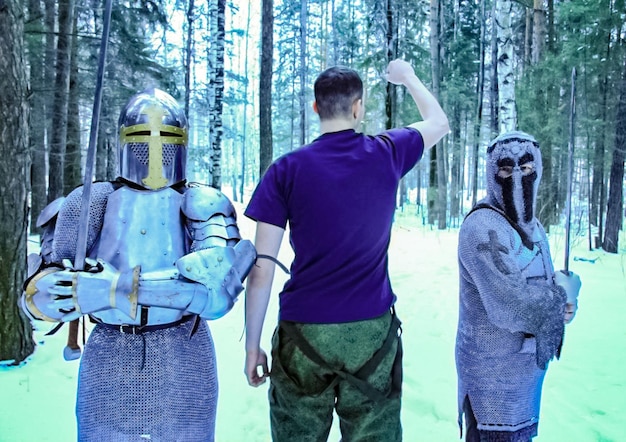
The narrative power of a single outfit
Sometimes, a single outfit can define an entire character or a pivotal moment in their story. These singular outfits demonstrate that wardrobe shapes character, turning clothing into an immediate narrative cue.
Whether it’s a villain’s menacing uniform or a hero’s triumphant regalia, these costumes are imbued with such narrative power that they become inseparable from the character’s persona.
They are not merely costumes; they are statements that resonate long after the credits roll, highlighting once more that wardrobe shapes character.
Moreover, the deterioration or alteration of a costume can also signify character evolution. A frayed coat on a character who began impeccably dressed can highlight their descent into poverty or despair.
Conversely, a character meticulously repairing their clothing might indicate their resilience and adaptability in the face of adversity.
These subtle changes speak volumes, affirming that wardrobe shapes character through visual storytelling.
Iconic costumes: More than just clothes
Certain costumes transcend their role as mere wardrobe, imprinting themselves onto cinematic history as iconic symbols.
Here again, the lesson is clear: wardrobe shapes character in ways that extend beyond the screen into cultural memory.
These costumes often encapsulate the very essence of a character at their most powerful or vulnerable, instantly communicating their story to generations of viewers.
They speak a universal language, needing no dialogue to convey meaning, proving definitively that wardrobe shapes character.
The designer-director collaboration: A creative partnership
The creation of compelling character costumes is rarely a solitary endeavor; it’s the result of a highly collaborative partnership between the costume designer and the film’s director.
This synergistic relationship is crucial for ensuring that the wardrobe choices align perfectly with the director’s vision for the story and character arcs.
It demands open communication, mutual respect, and a shared understanding of the narrative’s intricacies. Recognizing that wardrobe shapes character guides every decision in this collaborative process.
This collaboration typically begins early in pre-production, long before cameras start rolling, and continues throughout the filming process.
It’s an ongoing dialogue that shapes the visual identity of the characters and, by extension, the film itself. The central philosophy remains: wardrobe shapes character, and every choice must reflect the narrative.
Translating vision into fabric
The director sets the overall tone, theme, and underlying message of the film, providing the core vision that the costume designer must interpret.
The designer’s task is to translate these abstract concepts—moods, periods, character journeys—into tangible fabric, color, and silhouette.
Understanding that wardrobe shapes character ensures that visual storytelling aligns with narrative intent.
- Initial Briefs: Director outlines character arcs and narrative themes.
- Visual Research: Designer gathers inspiration, references, and proposes initial concepts.
- Feedback Loops: Iterative process of sketches, fabric samples, and fittings with director’s input.
The role of actor input
While the director and designer hold primary creative control, the actor’s input is also invaluable.
An actor inhabits the character, and their comfort and confidence in the costume can significantly impact their performance.
Fittings are opportunities for the actor to connect with their character physically, exploring how wardrobe shapes character and influences movement, posture, and demeanor.
Sometimes, an actor might offer insights into how a costume feels or moves, suggesting minor adjustments that could enhance their portrayal.
This dynamic ensures that the costumes are not only visually appealing but also functional and authentic to the character being embodied, reinforcing the idea that wardrobe shapes character at every level.
Challenges and innovations in costume design
The field of costume design is constantly evolving, presenting unique challenges and fostering incredible innovations.
Understanding that wardrobe shapes character motivates designers to innovate while maintaining narrative fidelity.
From digitally aging garments to sourcing eco-friendly materials, modern costume designers are at the forefront of creative problem-solving.
Budget constraints and sustainability demands push them to experiment with new materials, techniques, and technologies.
These innovations ensure that wardrobe shapes character remains relevant in contemporary filmmaking.
Budget constraints and creative solutions
One of the most persistent challenges in costume design is working within budget constraints. Designers often need to achieve a grand visual effect with limited resources.
Cleverly sourcing fabrics, repurposing garments, or using thrift finds illustrates how wardrobe shapes character without excessive cost.
- Thrift Store Sourcing: Finding unique or adaptable pieces from second-hand shops.
- Fabric Manipulation: Using dyeing, distressing, or embellishment to transform basic materials.
- Strategic Reuse: Adapting costumes from previous productions or rentals to fit new narratives.
Sustainability and ethical practices
Increasingly, costume designers are embracing sustainability and ethical production practices.
The industry’s environmental footprint drives the need for conscious material choices, and designers ensure that wardrobe shapes character while supporting responsible consumption.
Technological innovations like 3D printing and digital rendering enable intricate costume details while minimizing waste, allowing designers to explore how wardrobe shapes character in both physical and virtual mediums.
The undeniable impact of wardrobe on audience perception
The impact of wardrobe choices extends far beyond the production crew and the actors themselves; it profoundly shapes how the audience perceives a character.
Every choice, from silhouette to fabric, illustrates how wardrobe shapes character in subtle yet powerful ways.
First impressions and character archetypes
A character’s initial appearance, largely defined by their costume, forms the audience’s very first impression.
Costume designers leverage archetypal associations to ensure that wardrobe shapes character and communicates narrative intent instantly.
- Visual Cues: Immediate signals about wealth, profession, or personality type.
- Archetypal Reinforcement: Using established visual codes to quickly define a character role.
- Subversion of Expectations: Dressing a character in unexpected ways to create intrigue or plot twists.
Generating empathy and relatability
Costumes are a key vehicle for emotional connection. A tattered coat or carefully curated outfit conveys struggle, resilience, or aspiration, demonstrating how wardrobe shapes character and fosters audience empathy.
When costumes authentically reflect the character’s circumstances, the audience engages more deeply with the narrative.
Conversely, ill-conceived wardrobe choices can disrupt immersion, proving that wardrobe shapes character is essential for storytelling impact.
Future of costume design and its enduring legacy
As film and television continue to evolve, the art of costume design will increasingly integrate technology, sustainability, and narrative innovation.
Yet the principle remains timeless: wardrobe shapes character, ensuring that costumes continue to enrich storytelling.
- Technological Integration and Digital Costumes: Virtual wardrobes, CGI enhancements, and motion capture allow designers to explore new ways wardrobe shapes character in complex genres.
- Intersection of Fashion and Storytelling: Designers influence street style while ensuring that wardrobe shapes character remains authentic and compelling.
Regardless of advancements, the human understanding of psychology and non-verbal communication ensures that wardrobe shapes character remains central to cinematic storytelling.
Iconic costumes, whether digital or physical, demonstrate that clothing is a narrative force, shaping perception, identity, and audience connection for generations.
| Key Aspect | Brief Description |
|---|---|
| 🎨 Narrative Tool | Wardrobe acts as a non-verbal language, communicating character traits, status, and emotional states. |
| 📈 Character Evolution | Costumes evolve with characters, visually marking transformations and plot developments. |
| ⭐ Iconic Power | Certain outfits become iconic, symbolizing key characters and moments in cinematic history. |
| 🤝 Collaborative Art | Success relies on close collaboration between designers, directors, and actors. |
Frequently Asked Questions (FAQ) about Wardrobe Shapes Character
Costume choices reveal personality through elements like color, texture, fit, and style. A bold color might indicate confidence, while subdued tones suggest introspection. Fabric choices can reflect comfort levels or social standing. Even subtle details like worn-out shoes versus pristine footwear communicate volumes about a character’s habits and disposition.
While both involve clothing, costume design serves a narrative purpose within a film or theatrical production, focusing on character development and storytelling. Fashion design, conversely, aims to create trends and sell garments for everyday wear or high fashion, prioritizing aesthetic appeal and commercial viability. Costume designers often prioritize storytelling over pure trendiness.
Historical accuracy provides a strong foundation for period costumes, ensuring authenticity and grounding the narrative in a specific era. However, designers often take artistic liberties to enhance character development or visual impact for a modern audience. The goal is to capture the essence of the period while still serving the storytelling needs of the film.
Absolutely. Iconic costumes, like Dorothy’s ruby slippers or Darth Vader’s suit, become intrinsically linked to the characters they adorn. These singular outfits are meticulously designed to encapsulate a character’s essence, motivations, or pivotal narrative moment, immediately communicating their role and impact to the audience without any dialogue.
Contemporary costume designers face challenges such as budget constraints, the need for increased sustainability in their practices, and integrating new technologies like 3D printing and digital rendering. They also navigate the blurred lines between film and fashion, continually finding innovative ways to create visually compelling and narratively rich wardrobes.
